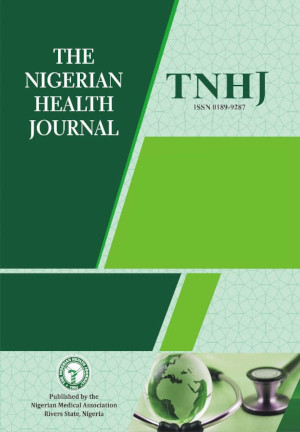Black Soot: A Threat to the Environment and Population’s Health in Rivers State Nigeria
DOI:
https://doi.org/10.60787/tnhj.v23i1.631Keywords:
Black soot, environment, cardiovascular health, Rivers State, NigeriaAbstract
Air pollution is harmful to the environment and the habiting population. Rivers state is not new to this as black soot continues to accumulate in the air and exert unpleasant effects on the environment and the health of occupants of the state. The soot has caused deteriorating effects on the aesthetics of the environment, affecting both soil and water bodies, disrupting agricultural practices and contributing to climate change. Population health has also not been spared, with the increased presence of carcinogenic elements in the atmosphere, alongside an increased risk for respiratory diseases such as bronchitis and asthma. There is a need for proper documentation of black soot events in Rivers State. New policies should be created and adopted to reduce its formation. Mass media activity to enlighten the public on the threats of Black Soot is needed. Preventive measures that can be effective in curbing the situation should be provided.
References
World HealthOrganization (WHO). WHO Releases Country Estimates on Air Pollution Exposure and Health Impact. Available online: http://www.who.int/mediacentre/news/releases/2016/air-pollution-estimates/en/. Assessed on 19 June 2022.
Fagbeja, M.A.; Hill, J.; Chatterton, T.; Longhurst, J.; Akinyede, J. Residential-Source Emission Inventory for the Niger Delta—A Methodological Approach. J. Sustain. Dev. 2013, 6, 98–120.
Ede, P.N. Pollution and the Rivers State Environment. Niger. Res. Rev. 1998, 1, 81–89
The Guardian. Air Pollution: Rivers Resident Decry Invasion by Black Soot. Available online:https://guardian.ng/sunday-magazine/air-pollution-rivers-resident-decry-invasion-by-black-soot/
Sweet Crude. Nigeria: Cancer-Causing Black Soot Assail Port Harcourt, Residents Panic. Available online: http://sweetcrudereports.com/2017/02/11/nigeria-cancer-causing-black-soot-assailport-harcourt-residents-panic/
Orji Sunday. Black soot still plagues the residents of the Niger Delta City Monitor 2020, available at https://citymonitor.ai/environment/pollution/black-soot-still-plagues-the-residents-of-the-niger-delta
Donald McCubbin, "Health Benefits of Alternative PM2.5 Standards" (Washington: American Lung Association, Clean AirTask Force, Earthjustice). 2011. Available at https://www.earthjustice/sites/default/files/Health-Benefits-Alternative-PM2.5Standards.pdf
Ihesinachi A.K, Amalo N. Dibofori-Orji, Ozioma AE. Exposure to Heavy Metals in Soot samples and Cancer Risk Assessment in Port Harcourt, Nigeria. 2019; 9(24).doi.org/10.5696/2156-9614-9.24.191211
Arsenic, metals, fibres and dust: IARC monographs on the evaluation of carcinogenic risks to humans. Vok 100 C; a review of human carcinogens. Lyon,France International Agency for Research on Cancer. 2012. 527
Obiorah, Christopher and Abu, Emmy. Breast Cancer in Rivers State Nigeria: Ten-year review of the Port Harcourt Cancer Registry. South African Journal of Oncology. 2019; 3(0). a58. https://doi.org/10.4102/sajo.v3i0.58
Downloads
Published
How to Cite
Issue
Section
License
Copyright (c) 2023 Journal and Publisher

This work is licensed under a Creative Commons Attribution-NonCommercial-NoDerivatives 4.0 International License.
The Journal is owned, published and copyrighted by the Nigerian Medical Association, River state Branch. The copyright of papers published are vested in the journal and the publisher. In line with our open access policy and the Creative Commons Attribution License policy authors are allowed to share their work with an acknowledgement of the work's authorship and initial publication in this journal.
This is an open access journal which means that all content is freely available without charge to the user or his/her institution. Users are allowed to read, download, copy, distribute, print, search, or link to the full texts of the articles in this journal without asking prior permission from the publisher or the author.
The use of general descriptive names, trade names, trademarks, and so forth in this publication, even if not specifically identified, does not imply that these names are not protected by the relevant laws and regulations. While the advice and information in this journal are believed to be true and accurate on the date of its going to press, neither the authors, the editors, nor the publisher can accept any legal responsibility for any errors or omissions that may be made. The publisher makes no warranty, express or implied, with respect to the material contained herein.
TNHJ also supports open access archiving of articles published in the journal after three months of publication. Authors are permitted and encouraged to post their work online (e.g, in institutional repositories or on their website) within the stated period, as it can lead to productive exchanges, as well as earlier and greater citation of published work (See The Effect of Open Access). All requests for permission for open access archiving outside this period should be sent to the editor via email to editor@tnhjph.com.




